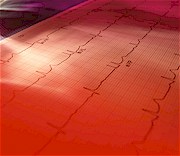Brugada syndrome is an unusual genetic disorder of the heart's electrical system. Although people are born with it, they usually do not know they have it until they reach their 30s or 40s. The only symptoms of Brugada syndrome are passing out (called syncope), or heart palpitations, or sudden cardiac death.
What causes Brugada syndrome?
Your heart's electrical system requires that electrical signals be sent through specialized electrical tissue and through the heart muscle itself (called the myocardium). These electrical tissues and the myocardium are able to conduct electricity because of special molecules called ion channels, which allow positively and negatively charged particles to pass through the cells' walls.
With Brugada syndrome, there is a defect in one of those ion channels. In about 1 of 3 patients, the defect is in the specific ion channel called the "SCN5A". This defect can lead to a dangerous heart rhythm called ventricular fibrillation, which is a much faster, chaotic heartbeat that sometimes reaches 300 beats a minute. This chaotic heartbeat means very little blood is pumped from the heart to the brain and the body and can be life threatening.
What are the risk factors?
Brugada syndrome is usually an inherited condition, which means it is passed down through family members. In about one-third of patients, doctors know which gene is responsible for the condition.
In some cases, the signs of Brugada syndrome are mimicked by electrolyte imbalances, certain hormone disorders, or by cocaine use. In these cases, doctors still think that a genetic defect is the cause of Brugada syndrome, but that the defect is not severe enough to cause problems on its own.
Brugada syndrome occurs more often in men than in women. It is usually diagnosed in adults between 25 and 50 years old. It is rarely present in young children. Brugada syndrome is found more often in people of Asian descent than in any other race.
What are the signs and symptoms?
Many people who have Brugada syndrome do not have any symptoms, so they do not even know they have it. If people do have symptoms, they may include
-
Fainting
-
Irregular heartbeats (
arrhythmias) or heart palpitations
-
How is Brugada syndrome diagnosed?
If your doctor thinks you might have Brugada syndrome, he or she may order the following tests:
-
An
electrocardiogram (ECG or EKG), which helps doctors analyze the electrical currents in your heart and the patterns of your heartbeat. During this test, doctors are looking for a certain kind of arrhythmia called a Brugada sign. A
Brugada sign is a pattern of heartbeats that only happens in people with Brugada syndrome. However, not all patients with Brugada syndrome will have a Brugada sign, and the ECG may look completely normal. If this is the case, patients may need to have a number of ECGs at different times. In some cases, doctors may give a medicine that makes the Brugada sign more obvious.
-
Electrophysiology studies (EPS), which are usually done in a cardiac catheterization laboratory. Doctors usually perform this test when patients have the Brugada sign but do not have any symptoms. During this test, a long, thin tube called a catheter is inserted into an artery in your leg and guided to your heart. A map of electrical impulses from your heart is sent through the catheter. This map helps doctors find out what kind of arrhythmia you have and where it starts. During this test, doctors may even cause the electrical problems to happen while you are in the safe and controlled environment of the hospital.
How is Brugada syndrome treated?
If your doctor thinks that treatment is needed, the only proven treatment for Brugada syndrome is an implantable cardioverter defibrillator (ICD). This small device monitors your heart rhythm and delivers electrical shocks when needed to control abnormal heartbeats.
People with Brugada syndrome can lead normal lives. Whether or not you have an ICD to treat your Brugada syndrome, it is important to have regular check-ups with your doctor, just to make sure that you have the condition under control. Because Brugada syndrome runs in families, it may be a good idea for family members to be screened, as well.
Return to main topic: Congenital Heart Disease
See on other sites:
Genetics Home Reference, National Library of Medicine
ghr.nlm.nih.gov/condition=brugadasyndrome
Brugada syndrome
Texas Adult Congenital Heart Center (TACH)
www.bcm.edu/healthcare/care-centers/congenital-heart
This Baylor College of Medicine program enables patients with congenital heart disease to receive a seamless continuation of care from birth to old age.
Updated August 2016



